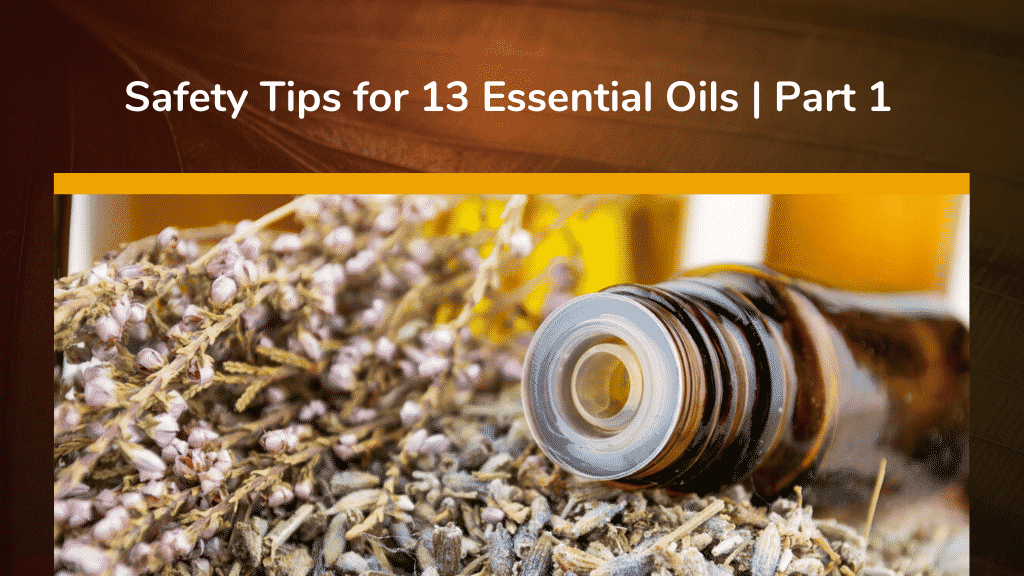 By ACHS Founding President Dorene Petersen, BA, Dip.NT, Dip.Acu, RH (AHG)
By ACHS Founding President Dorene Petersen, BA, Dip.NT, Dip.Acu, RH (AHG)
In this blog post, ACHS Founding President Dorene Petersen shares her expertise with valuable safety tips for six essential oils. In part 2 next week, she will share tips for seven more essential oils.

1. Essential Oil of Lavender
Lavandula officinalis (Chaix.), L. vera (DC.), L. angustifolia (Mill.), or Lavandula vera (DC.) are considered a source of the essential oil.
Family: Lamiaceae
Recommended Daily Use Adults
Topical application:
Adults: Dilute 6 drops in 2 teaspoons (10ml) of carrier oil or another safe diluent. Use this diluted preparation over a 24 hour period in 3 to 4 topical applications, or use the complete amount for one full bath.
Dilution ratio 2%.
Please note: These dilution ratios are based on the conversion of 30 drops of essential oil = 1ml.
Inhalation:
Adults: Inhaled via a diffuser. Note: When diffusing, don’t exceed 30 minute intervals and diffuse in well-ventilated areas.
If any adverse reactions occur, discontinue use and consult with a physician.
Cautions and Contraindications
Lavender essential oil may cause skin sensitivity. The potential skin sensitizing constituents are linalool and linalyl acetate which are prone to altering on exposure to air. Oxidized linalool and linalyl acetate within lavender essential oil may cause allergic skin reactions.[1] A skin patch test is recommended if lavender is to be used on a regular basis or if there is a history of allergic skin reactions.
Toxic Rating
The American College of Healthcare Sciences toxic rating is a I.[2]
Regulatory Status
Lavender essential oil is listed on the FDA Substances Added to Food List formerly the Everything Added to Food in the U. S. (EAFUS) list.[3] Lavender flowers and two of the constituents of lavender, linalool (linalol), and linalyl acetate, are on Substances Generally Recognized as Safe [4]List (GRAS)[5]
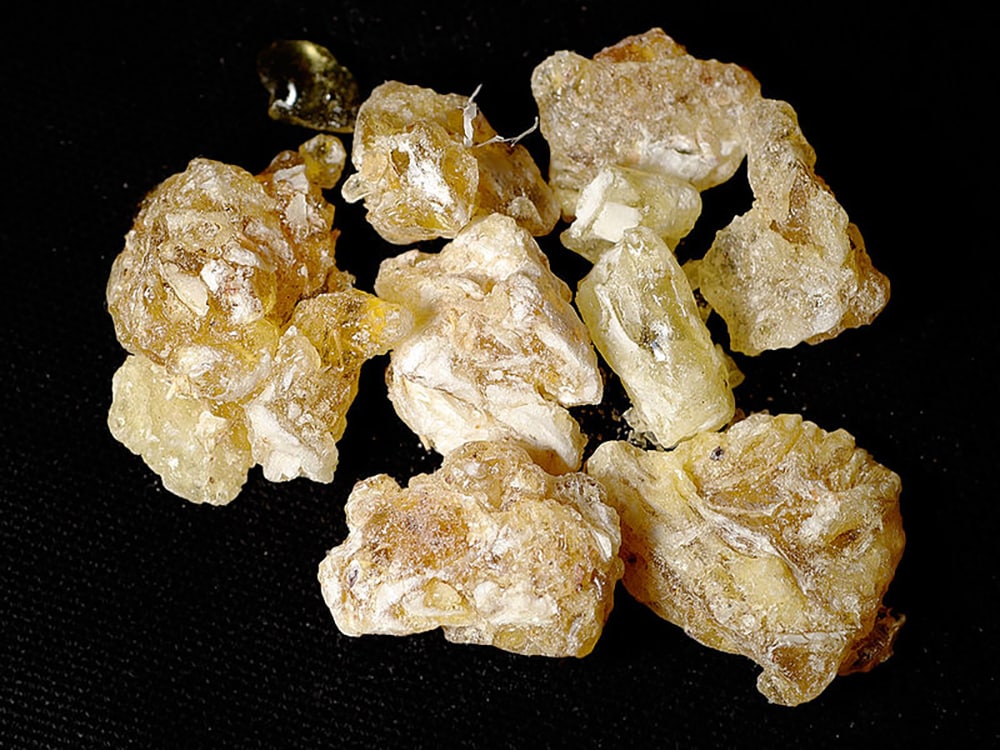
2. Essential Oil of Frankincense
Boswellia serrata, Boswellia sacra, synonym Boswellia carteri
It is also known as Olibanum.
Family: Burseraceae
Recommended Daily Use
Topical application:
Adults: Dilute 6 drops in 2 teaspoons (10ml) of carrier oil or another safe diluent. Use this diluted preparation over a 24 hour period in 3 to 4 topical applications, or use the complete amount for one full bath.
Dilution ratio 2%.
Please note: These dilution ratios are based on the conversion of 30 drops of essential oil = 1ml.
Inhalation:
Adults: Inhaled via a diffuser. Note: When diffusing, don’t exceed 30 minute intervals and diffuse in well-ventilated areas.
If any adverse reactions occur, discontinue use and consult with a physician.
Cautions and Contraindications
Each species of frankincense or boswellia oil presents a unique constituent profile and therefore may have unique associated cautions and contraindications. The presence of α-pinene, (+)-limonene and/or δ-3-carene in some species increases the likelihood of oxidation. Oxidized frankincense can cause skin sensitization therefore careful storage in cool and dark conditions is required.
Toxic Rating
The American College of Healthcare Sciences toxic rating is a I.[6]
Regulatory Status
Frankincense essential oil is listed on the FDA Substances Added to Food (formerly EAFUS) list.[7],[8]

3. Essential Oil of Patchouli
Pogostemon cablin (Benth.) (synonym Pogostemon patchouli)
Family: Lamiaceae
Recommended Daily Use
Topical application:
Adults: Dilute 3 drops in 2 teaspoons (10ml) of carrier oil or another safe diluent. Use this diluted preparation over a 24 hour period in 3 to 4 topical applications, or use the complete amount for one full bath.
Dilution ratio 1%.
Please note: These dilution ratios are based on the conversion of 30 drops of essential oil = 1ml.
Inhalation:
Adults: Inhaled via a diffuser. Note: When diffusing, don’t exceed 30 minute intervals and diffuse in well-ventilated areas.
If any adverse reactions occur, discontinue use and consult with a physician.
Cautions and Contraindications
The potentially toxic constituents are patchoulenone and cinnamic acid. Avoid the use of patchouli essential oil if you are using anti-platelet medication, having surgery, or experiencing any clotting issues as it contains a constituent (alpha-bulnesene) that can potentially inhibit blood clotting.[9] [10]
Toxic Rating
The American College of Healthcare Sciences toxic rating is II.[11]
Regulatory Status
Patchouli essential oil is listed on the FDA Substances Added to Food List formerly the Everything Added to Food in the U. S. (EAFUS) list.[12]

4. Essential Oil of Blue Chamomile
Matricaria recutita L.
Family: Asteraceae (formerly Compositae)
Recommended Daily Use
Topical application:
Adults: Dilute 3 drops in 2 teaspoons (10ml) of carrier oil or another safe diluent. Use this diluted preparation over a 24 hour period in 3 to 4 topical applications, or use the complete amount for one full bath.
Dilution ratio 1%.
Please note: These dilution ratios are based on the conversion of 30 drops of essential oil = 1ml.
Inhalation:
Adults: Inhaled via a diffuser. Note: When diffusing, don’t exceed 30 minute intervals and diffuse in well-ventilated areas.
If any adverse reactions occur, discontinue use and consult with a physician.
Cautions and Contraindications
Blue chamomile essential oil contains constituents, chamazulene and alpha-bisabolol, that can inhibit the activities of P450 cytochrome pathway drug metabolizing enzymes which increases the plasma level of medication.[13] Caution should be applied if using blue chamomile essential oil at the same time as some antidepressants, anti-nausea, anticoagulant, and anti-asthma drugs amongst others.[14] American College of Healthcare Science recommends it is avoided during pregnancy as the P450 cytochrome pathway enzymes may naturally reduce during this time. Coupled with the fact that these enzymes also detoxify pesticides during pregnancy and any reduction of them could potentially affect fetal development.[15] For external applications, apply a skin patch test as it may cause dermatitis in some individuals. If a client is allergic to ragweed Ambrosia artemisiifolia (L.), or other members of the Asteraceae family take extra precautions[16]
Toxic Rating
The American College of Healthcare Sciences toxic rating is II[17] and a skin patch test is recommended if skin is hypersensitive or if you are allergic to plants in the Asteraceae family.
Regulatory Status
Blue chamomile flower (not the essential oil) is listed on the FDA Substances Added to Food list formerly the Everything Added to Food in the U. S. (EAFUS) list.[18] Blue chamomile essential oil is listed on the Substances Generally Recognized as Safe [19]List (GRAS)[20]
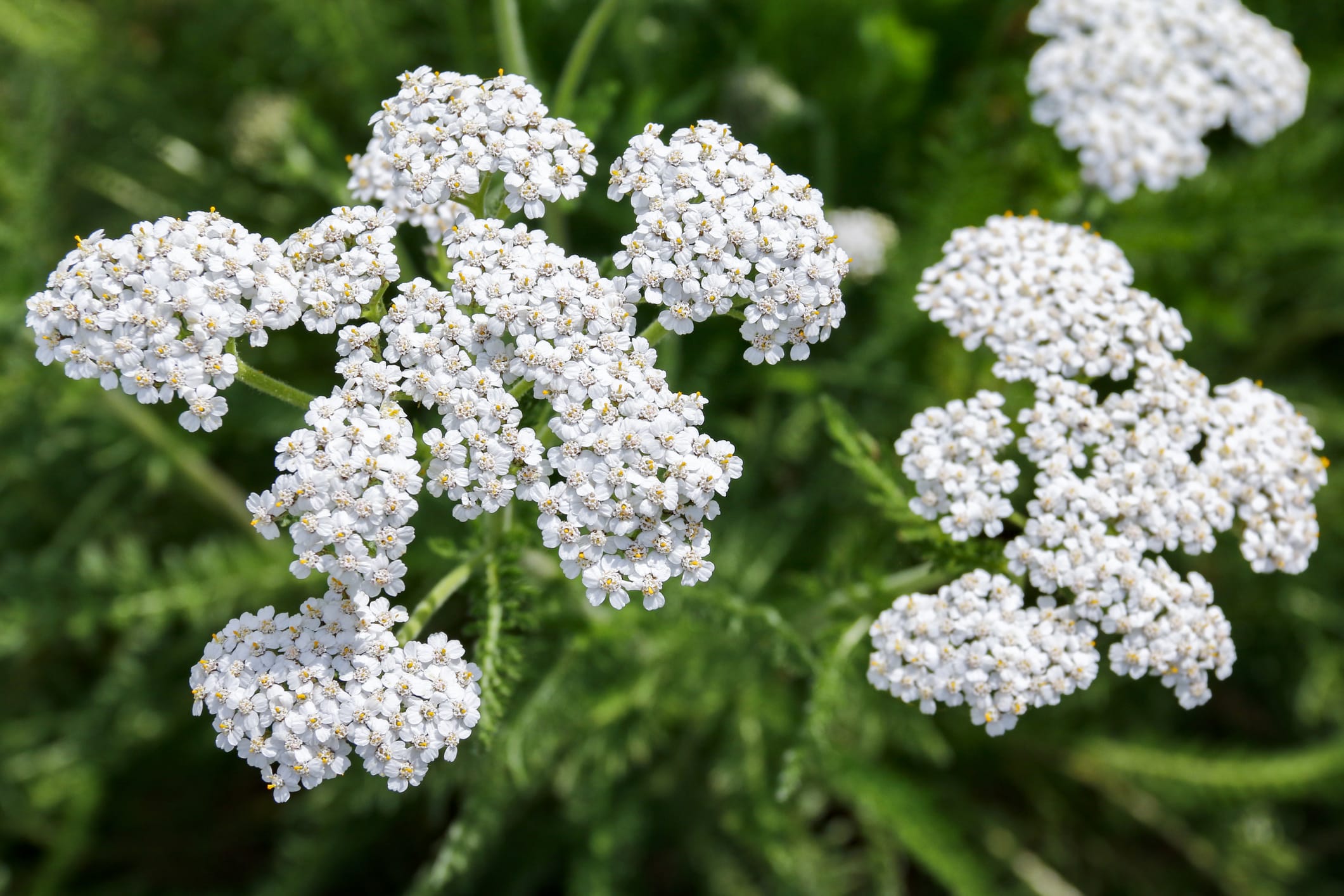
5. Essential Oil of Blue Yarrow
Achillea millefolium (L.)
Family: Asteraceae (formerly Compositae)
Recommended Daily Use
Topical application:
Adults: Adults: Dilute 3 drops in 2 teaspoons (10ml) of carrier oil or another safe diluent. Use this diluted preparation over a 24 hour period in 3 to 4 topical applications, or use the complete amount for one full bath.
Dilution ratio 1%.
Please note: These dilution ratios are based on the conversion of 30 drops of essential oil = 1ml.
Inhalation:
Adults: Inhaled via a diffuser. Note: When diffusing, don’t exceed 30 minute intervals and diffuse in well-ventilated areas.
If any adverse reactions occur, discontinue use and consult with a physician.
Cautions and Contraindications
The toxic constituents are camphor[21] and thujone[22]. Both are considered neurotoxins. It also contains the constituent chamazulene. Camphor, thujone and chamazulene all interact with the P450 Cytochrome pathway, specifically CYP2A6 (camphor and thujone) and CYP1A2, CYP2D6, and CYP3A4 (chamazulene).[23] If yarrow is used above the recommended daily use amounts it may induce change in the CYP enzymes and result in a modulation of metabolic clearance of both prescription drugs and toxic compounds.
Despite these potential toxic constituents the Commission E Monographs lists no known side effects for yarrow, and no known drug interactions[24]
It is contraindicated for use during pregnancy because of these constituents and also due to its emmenagogue and uterine stimulant activity.[25] It should also be avoided while breastfeeding.
People who have allergies to members of the Asteraceae family should either avoid its use or immediately cease use should allergic reactions appear, such as itching and inflammatory changes to the skin.
United States Federal Regulations require that food or beverage products containing yarrow be thujone-free.[26]
Dosages of yarrow essential oil above the recommended daily use may interfere with anticoagulant, hypo and hypertensive therapies, and have sedative and diuretic effects.[27]
Toxic Rating
The American College of Healthcare Sciences toxic rating is II and a skin patch test is recommended if skin is hypersensitive or if you are allergic to plants in the Asteraceae family.[28]
Regulatory Status
Yarrow essential oil is listed on the FDA Substances Added to Food list formerly the Everything Added to Food in the U. S. (EAFUS) list.[29]
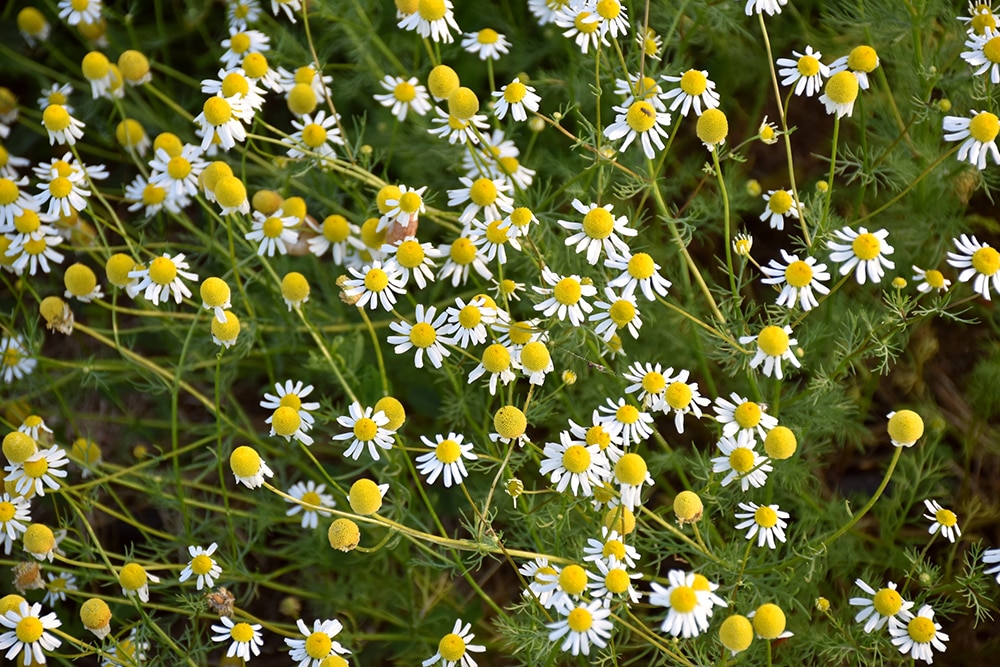 6. Essential Oil of Roman Chamomile
6. Essential Oil of Roman Chamomile
Chamaemelum nobile (L.) All. (formerly Anthemis nobilis)
Family: Asteraceae (formerly Compositae)
Recommended Daily Use
Topical application:
Adults: Dilute 6 drops in 2 teaspoons (10ml) of carrier oil or another safe diluent. Use this diluted preparation over a 24 hour period in 3 to 4 topical applications, or use the complete amount for one full bath.
Dilution ratio 2%.
Please note: These dilution ratios are based on the conversion of 30 drops of essential oil = 1ml.
Inhalation:
Adults: Inhaled via a diffuser. Note: When diffusing, don’t exceed 30-minute intervals and diffuse in well-ventilated areas.
If any adverse reactions occur, discontinue use and consult with a physician
Cautions and Contraindications
For external applications, apply a skin patch test, because it may cause dermatitis in some individuals. If a client is allergic to ragweed Ambrosia artemisiifolia (L.), or other members of the Asteraceae family take extra precautions.[30]
Toxic Rating
The American College of Healthcare Sciences toxic rating is I and a skin patch test is recommended if skin is hypersensitive or if you are allergic to plants in the Asteraceae family.[31]
Regulatory Status
Roman chamomile essential oil is listed on the FDA Generally Recognized as Safe (GRAS) list and on the FDA Substances Added to Food list formerly the Everything Added to Food in the U. S. (EAFUS).[32] [33]
Leave us a comment if you found this article helpful or have any questions, and we look forward to bringing you Part 2 next week. Visit the ACHS Apothecary Shoppe to purchase many of the essential oils from this series, pesticide-free, organic, and sustainably sourced.
Disclaimer: This article is for informational purposes only. It is not intended to treat, diagnose, cure, or prevent disease. This article has not been reviewed by the FDA. Always consult with your primary care physician or naturopathic doctor before making any significant changes to your health and wellness routine.
References:
[1] SCCS (Scientific Committee on Consumer Safety). (2011). Opinion on fragrance allergens in cosmetic products [PDF file]. Retrieved from https://ec.europa.eu/health/scientific_committees/consumer_safety/docs/sccs_o_073.pdf
[2] Toxic Rating: I = Low, II = Moderate, III = High (Low Therapeutic Margin) Toxic Rating: I = Low, II = Moderate, III = High (Low Therapeutic Margin)
Toxic Rating: I = Low: Low level of risk to most people if used within the recommended daily use guidelines.
Toxic Rating: II = Moderate: Potential risk for people with sensitive skin or a chronic condition such as asthma. Dose and duration should be observed. Review all contraindications and potential drug interactions prior to use.
Toxic Rating: III = High (Low Therapeutic Margin) High risk only to be used by Registered aromatherapists where potential benefits outweigh the risk. Very dose and duration specific and all contraindications and drug interactions must be observed. Not be used during pregnancy or breastfeeding.
Low therapeutic margin: Use the smallest amount possible to get the desired effect. Some essential oils and herbs have a low therapeutic margin, which means that the dividing line between a therapeutic dose and a harmful dose is very small. When we are working with drops it is important to be precise.
[3] U.S. Food & Drug Administration. (2020, January 14). Substances added to food (formerly EAFUS). Retrieved from https://www.accessdata.fda.gov/scripts/fdcc/?set=FoodSubstances&sort=Sortterm&order=ASC&startrow=1&type=basic&search=lavender
[4] Electronic Code of Federal Regulation. (2020, January 27). Subpart A-General provisions. Retrieved from https://www.ecfr.gov/cgi-bin/retrieveECFR?gp=&SID=3d8c169c5de41bf23cc4dda73d62e879&mc=true&n=sp21.3.182.a&r=SUBPART&ty=HTML#se21.3.182_150
[5]U.S. Food & Drug Administration. (2019, April 1). CFR: code of federal regulations title 21. Retrieved from https://www.accessdata.fda.gov/scripts/cdrh/cfdocs/cfcfr/cfrsearch.cfm?cfrpart=182&showfr=1
[6] Toxic Rating: I = Low, II = Moderate, III = High (Low Therapeutic Margin)
[7]U.S. Food & Drug Administration. (2020, January 14). Substances added to food (formerly EAFUS). Retrieved from https://www.accessdata.fda.gov/scripts/fdcc/?set=FoodSubstances&sort=Sortterm&order=ASC&startrow=1&type=basic&search=lavender
[8]
U.S. Food & Drug Administration. (2020, January 14). Substances added to food (formerly EAFUS). Retrieved from https://www.accessdata.fda.gov/scripts/fdcc/?set=FoodSubstances&sort=Sortterm&order=ASC&startrow=1&type=basic&search=lavender
[9] H.C. Hsu, W.C. Yang, W.J. Tsai, et al.: Alpha-bulnesene, a novel PAF receptor antagonist isolated from Pogostemon cablin. Biochem. Biophys. Res. Commun. 345, 2006, 1033–1038.
[10] Tsai YC1, Hsu HC, Yang WC, Tsai WJ, Chen CC, Watanabe T.: Alpha-bulnesene, a PAF inhibitor isolated from the essential oil of Pogostemon cablin Institute of Biochemistry and Molecular Biology National Yang-Ming University, Taipei, Taiwan.Fitoterapia. 2007 Jan;78(1):7-11. Epub 2006 Sep 23.
[11] Toxic Rating: I = Low, II = Moderate, III = High (Low Therapeutic Margin)
[12]
U.S. Food & Drug Administration. (2020, January 14). Patchouly, oil (Pogostemon, spp). Retrieved from https://www.accessdata.fda.gov/scripts/fdcc/index.cfm?set=FoodSubstances&id=PATCHOULYOILPOGOSTEMONSPP
[13] M. Ganzera, P. Schneider, H. Stuppner: Inhibitory effects of the essential oil of chamomile (Matricaria recutita L.) and its major constituents on human cytochrome P450 enzymes. Life Sci. 78, 2006, 856–861.
[14] Horn John R.,Hansten, PharmD Philip D., Get to Know an Enzyme: CYP1A2 retrieved from https://www.pharmacytimes.com/publications/issue/2007/2007-11/2007-11-8279 January 2020
[15] Fortin, M. C., Aleksunes, L. M., & Richardson, J. R. (2013). Alteration of the expression of pesticide-metabolizing enzymes in pregnant mice: potential role in the increased vulnerability of the developing brain. Drug metabolism and disposition: the biological fate of chemicals, 41(2), 326–331. doi:10.1124/dmd.112.049395
[16] Maddocks-Jennings, W. (2004). Critical incident: idiosyncratic allergic reactions to essential oils. Complement Ther Nurs Midwifery, 10(1):58-60.
[17] Toxic Rating: I = Low, II = Moderate, III = High (Low Therapeutic Margin)
[18]U.S. Food and Drug Administration. (2020, January 14). Chamomile flower (Matricaria Chamomilla L.). Retrieved from https://www.accessdata.fda.gov/scripts/fdcc/?set=FoodSubstances&id=CHAMOMILEFLOWERMatracariachamomilla&sort=Sortterm&order=ASC&startrow=1&type=basic&search=chamomile
[19] Electronic Code of Federal Regulations. (2020, January 23). Subpart A: General provisions. Retrieved fromhttps://www.ecfr.gov/cgi-bin/retrieveECFR?gp=&SID=3d8c169c5de41bf23cc4dda73d62e879&mc=true&n=sp21.3.182.a&r=SUBPART&ty=HTML#se21.3.182_150
[20] Electronic Code of Federal Regulations. (2020, January 23). Subpart A: General provisions. Retrieved from https://www.ecfr.gov/cgi-bin/retrieveECFR?gp=&SID=3d8c169c5de41bf23cc4dda73d62e879&mc=true&n=sp21.3.182.a&r=SUBPART&ty=HTML#se21.3.182_150
[21] Santos CD, Cabot JC. Persistent effects after camphor ingestion: a case report and literature review. J Emerg Med. 2015;48(3):298–304. doi:10.1016/j.jemermed.2014.05.015
[22] Radulović NS, Genčić MS, Stojanović NM, Randjelović PJ, Stojanović-Radić ZZ, Stojiljković NI. Toxic essential oils. Part V: Behaviour modulating and toxic properties of thujones and thujone-containing essential oils of Salvia officinalis L., Artemisia absinthium L., Thuja occidentalis L. and Tanacetum vulgare L. Food Chem Toxicol. 2017;105:355–369. doi:10.1016/j.fct.2017.04.044
[23] Zehetner, P., Hoferl, M., & Buchbauer, G. (2018). Essential oil components and cytochrome P450 enzymes: A review. Flavour Fragrance Journal, 34, 223-240. doi: 10.1002/ffj.3496
[24] Blumenthal, M. (Ed.). (1998). The Complete German Commission E Monographs: Therapeutic Guide to Herbal Medicines. Austin, TX: American Botanical Council, 233.
[25] McGuffin, M., Hobbs, C., Upton, R., & Goldberg, A. (Eds.). (1997). American Herbal Products Association’s Botanical Safety Handbook. Boca Raton, FL: CRC Press, 3.
[26] McGuffin, M., Hobbs, C., Upton, R., & Goldberg, A. (Eds.). (1997). American Herbal Products Association’s Botanical Safety Handbook. Boca Raton, FL: CRC Press, 3.
[27] Newall, C.A., Anderson, L.A., & Philpson, J.D. (1996). Herbal Medicine: A Guide for Healthcare Professionals. London, UK: The Pharmaceutical Press, 272.
[28] Toxic Rating: I = Low, II = Moderate, III = High (Low Therapeutic Margin)
[30] Maddocks-Jennings, W. (2004). Critical incident: idiosyncratic allergic reactions to essential oils. Complement Ther Nurs Midwifery, 10(1):58-60.
[31] Toxic Rating: I = Low, II = Moderate, III = High (Low Therapeutic Margin)
[32] Electronic Code of Federal Regulations. (2020, January 27). Subpart A: General provisions. Retrieved from https://www.ecfr.gov/cgi-bin/retrieveECFR?gp=&SID=3d8c169c5de41bf23cc4dda73d62e879&mc=true&n=sp21.3.182.a&r=SUBPART&ty=HTML#se21.3.182_150
[33] U.S> Food & Drug Administration. (2020, January 14). Chamomile flower, oil (Anthemis Nobilis L.). Retrieved from https://www.accessdata.fda.gov/scripts/fdcc/?set=FoodSubstances&id=CHAMOMILEFLOWEROIL&sort=Sortterm&order=ASC&startrow=1&type=basic&search=chamomile
SCCS (Scientific Committee on Consumer Safety). (2011). Opinion on fragrance allergens in cosmetic products [PDF file]. Retrieved from https://ec.europa.eu/health/scientific_committees/consumer_safety/docs/sccs_o_073.pdf
About American College of Healthcare Sciences

This commitment to our students and graduates reflects in our current survey results that reflect 98% of our students would recommend ACHS to a friend or family member.
We believe education is the most powerful tool for changing an individual and the world around us.
When a person enrolls as ACHS, it is vitally important that they graduate with tools they need to forge their own holistic and sustainable missions, build up their communities confidently and changing the face of healthcare with knowledge.
 President’s Message: End Of Year Reflectionsby American College of Healthcare Sciences●December 31, 2020
President’s Message: End Of Year Reflectionsby American College of Healthcare Sciences●December 31, 2020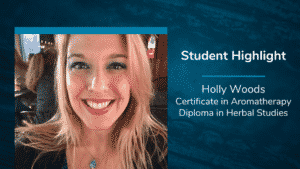 Student Highlight: Wife and Husband Team Start New Businessby American College of Healthcare Sciences●December 22, 2020
Student Highlight: Wife and Husband Team Start New Businessby American College of Healthcare Sciences●December 22, 2020 Student Highlight: Holistic Health, Gratitude, and Smoothies |achs.eduby American College of Healthcare Sciences●December 17, 2020
Student Highlight: Holistic Health, Gratitude, and Smoothies |achs.eduby American College of Healthcare Sciences●December 17, 2020 3 Tips For Building Better Habitsby American College of Healthcare Sciences●December 10, 2020
3 Tips For Building Better Habitsby American College of Healthcare Sciences●December 10, 2020
